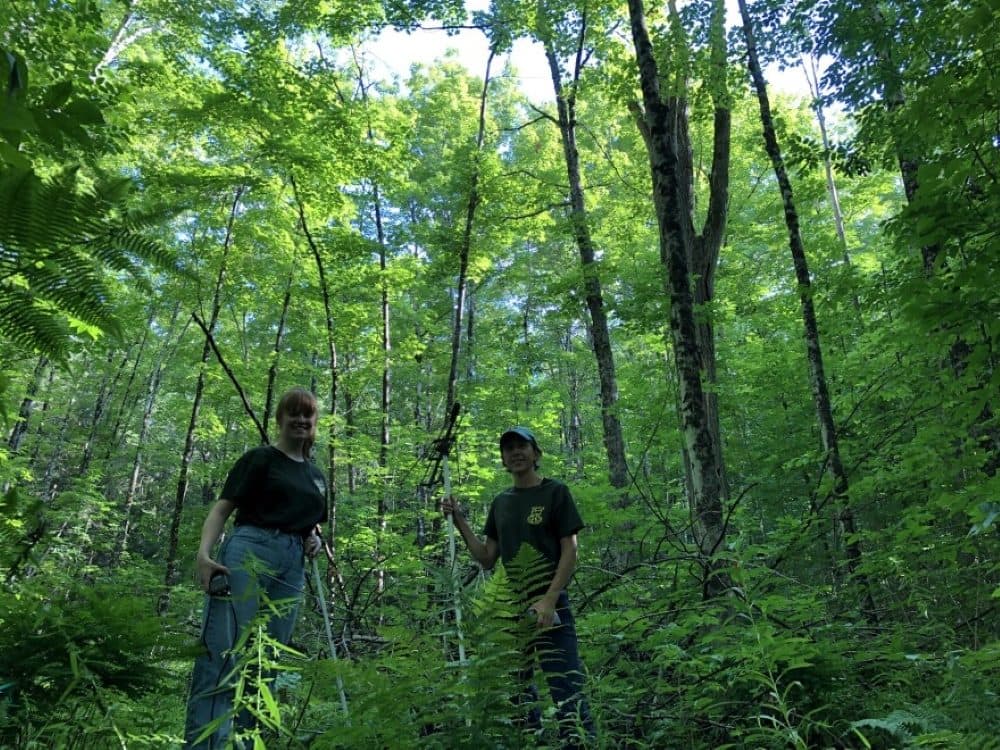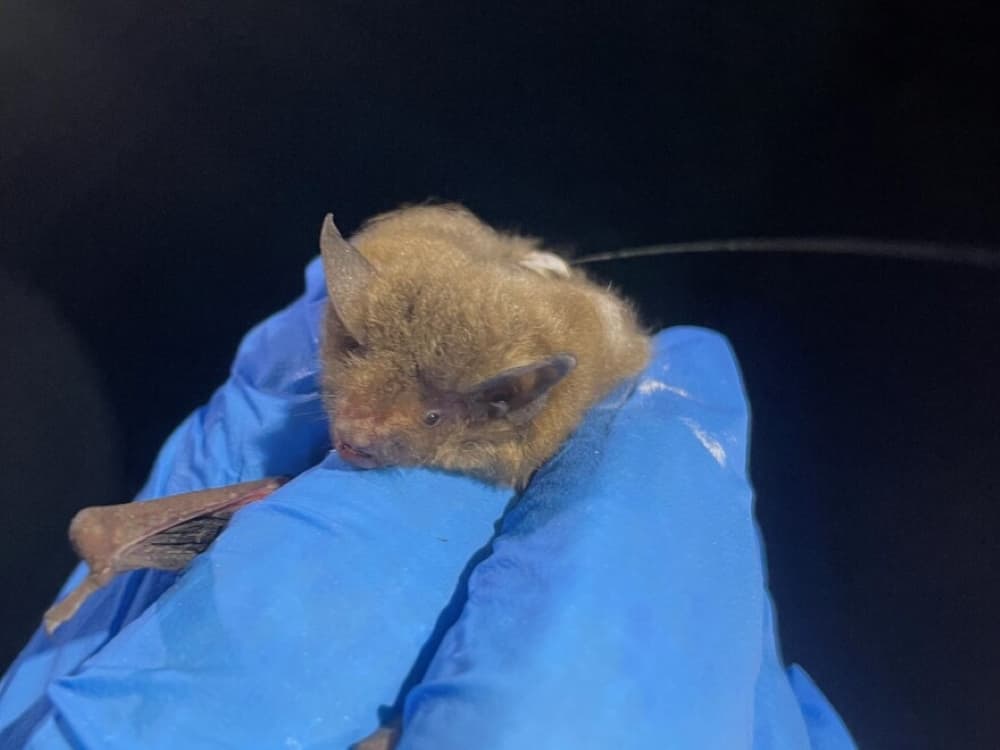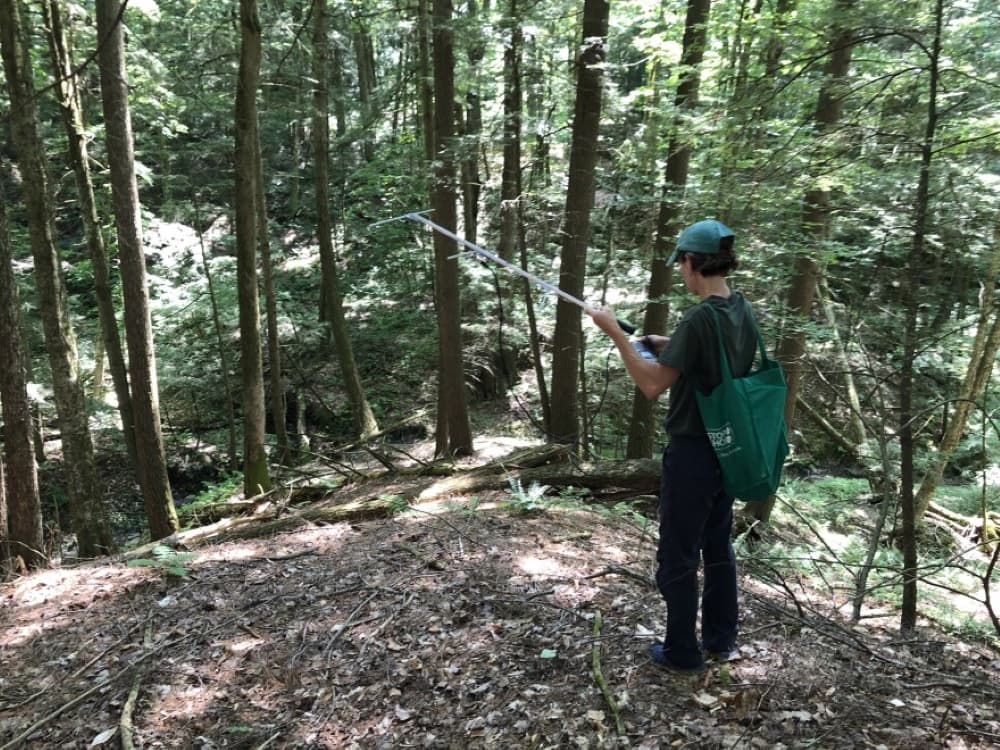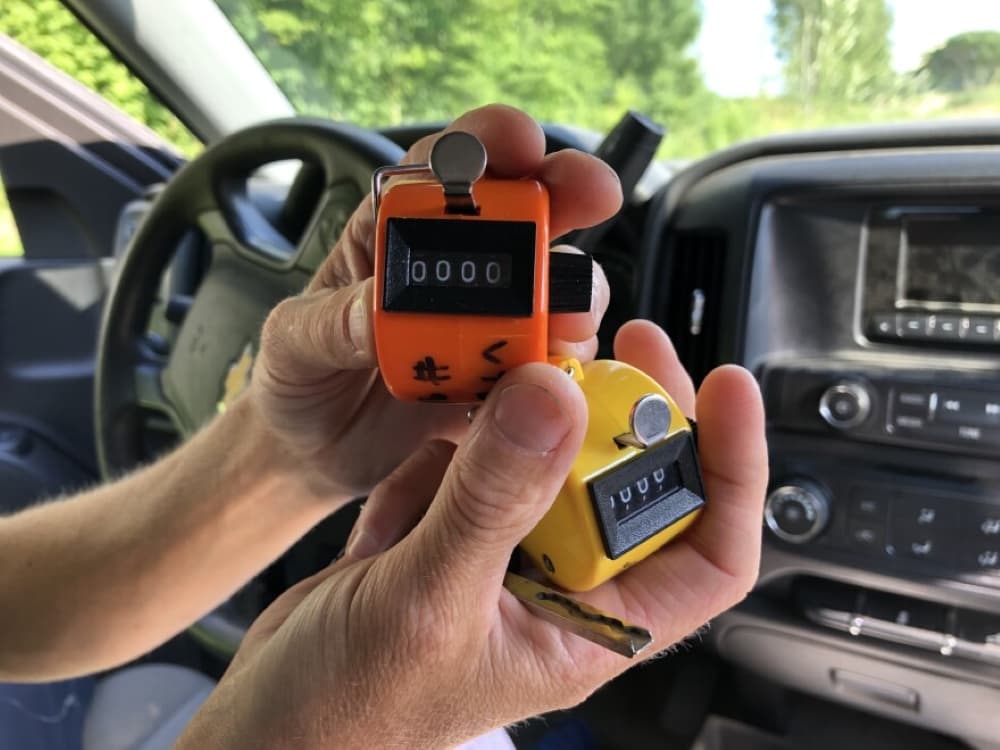Advertisement
A colony of endangered Indiana bats in Vermont could hold lessons for the species' recovery

On a hot (and buggy) July afternoon, Vermont Fish and Wildlife biologist Alyssa Bennett and summer intern Emily Paribello are traipsing through the woods. They’re each holding up big radio antennas, sweeping in all directions as they walk, hoping a beep will interrupt the static. They’re hot on the trail of Indiana bats. Three Indiana bats, specifically.
“We put some radio transmitters onto three lactating female Indiana bats last week that we captured in nets,” Bennett said. “We knew that bats had lived here historically.”
They knew because in 2008, biologists documented Indiana bats on this exact land in Hinesburg. (We’re not saying exactly where in Hinesburg, because endangered species’ habitats are protected, and Bennett worries people might harass or bother the bats if they knew where they were.)
This area has an ideal range of fields and woods, with lots of big standing dead trees that have peeling bark and are tall enough to get plenty of sunlight — exactly the kind of trees that Indiana bats like to roost in.
After that first discovery in 2008, the town got federal grant funding to manage and preserve the land for bats. This population is the farthest north and east Indiana bats have ever been found. They’re more abundant — though still rare — in the southern and midwestern states.
The Indiana bat has been protected for decades, but it’s even more vulnerable now. The fungus-caused white nose syndrome, first discovered on bats in a cave near Albany in 2006, has devastated bat populations. Some species have experienced 90% declines.
Bennett says Indiana bats didn’t suffer quite the same precipitous drop.
“But what we’ve seen with Indiana bats that initially declined by about 35% [because of white nose syndrome], is that over time they have continued to decline in many parts of their range," she said.
So there’s a lot of concern about whether the Indiana bat can recover. And this population in Hinesburg may hold some important clues.

When Bennett and her team went out to trap bats here earlier this month, they set up near three sets of bat boxes that had been built nearly a decade ago by a local Eagle Scout. They figured they’d mostly attract little brown bats, which look very similar to Indiana bats, just with different ears and fur coloration. If they were lucky, maybe one female Indiana bat would fly by.
Bennett brought along three transmitters — an aspirational number. But when the mist nets were set up and twilight descended, four female Indiana bats flew right into the nets.
The team was thrilled. Members affixed the radio transmitters and let the bats go. And then the next day they went out to see if those three bats could lead them to a larger colony.
Bennett says what they discovered was a surprise.
“We tracked two of the Indiana bats — no, all three of the Indiana bats back to two of the bat houses. We never imagined that we would track our Indiana bats back to these bat houses," she said.
Advertisement
That’s because Indiana bats have never been found roosting in bat boxes or any other kind of human-made structure in Vermont. And it’s rare elsewhere in their range, too.
But the biggest surprise happened when they started counting bats coming out of the bat houses that next evening.
“We have been counting bats coming out of these bat houses every night,” Bennett said. “And we’ve had over 100 coming out of each of the three sets of bat houses.”
In case you have no idea if that’s a lot or a little: it’s a lot. Post-white nose syndrome, most colony counts around the country have tallied about 50 to 80 Indiana bats. In this colony, Bennett estimates there are a total of 500, most of them with babies.
Bennett takes a measured tone when she explains all of this. But other wildlife officials express more outward excitement about Bennett’s discovery. Like Susi von Oettingen, an endangered species biologist with the U.S. Fish and Wildlife Service.
“I was flabbergasted! I mean, it’s amazing and I… I don’t understand it! What’s going on in Hinesburg?" she said.
That’s what Bennett’s trying to find out.
Female Indiana bats form loosely connected summer colonies. There’s a core group in the bat houses, but other clusters are scattered over a 2.5-mile range, and the bats can move every day. These 500 bats are all females and most of them have babies, called pups, that are born in midsummer. It takes the pups a month before they can fly, so the mothers are often moving their pups from roost to roost.
Every day since they trapped the three bats, Bennett and her team have been wandering through the nearby woods to find out where they’re sleeping off the sunlight. The researchers document how many bats are in each roost site, as well as all kinds of data about the tree or bat box and the landscape surrounding it.
But it’s a race against technology.
“These bats, when we captured them the other night, were between 6.5 and 7.5 grams each. And that’s just a couple of pennies in your hand. They’re very tiny," she said.
And the radio transmitters they affix to the bats’ backs need to be less than 5% of their body weight.
“But that battery is so tiny then, that when we put it on with the surgical glue, which just gives out in a couple of weeks, that’s about the same length as the battery," Bennett said.

So the team goes out every day, until the battery wears out and the transmitter falls off, to learn more about where the bats are going.
On this day, summer intern Emily Paribello has a hunch about where one of them might be tucked up. Her money is on a big old tree on some Fish and Wildlife easement land a few miles away.
Bennett and Paribello split up to search, and, after several miles of walking and wandering, the beep on one of the radio transmitters starts pinging. A faint sound at first — barely audible above the radio static — but stronger as Paribello gets closer to the not-so-poetically named 555’s location. She’s just where Paribello suspected.
“It’s that huge tree,” Paribello said, pointing to a large tree, rotting from the inside, with peeling bark standing taller than most of the surrounding foliage. “So that’s kind of ideal for the bats. Especially since it’s getting sun. And it seems like our bat is in there.”
They stand looking up at the tree for a little while and then continue on to search for the other two bats.
But they’ll be back at this tree at dusk to count how many bats leave this and the other roost sites.
Von Oettingen, with the U.S. Fish and Wildlife Service, says the discovery of 500 Indiana bats and the data Bennett’s team produces could pave the way for more research funding — desperately needed as scientists try to learn more about how bats are surviving white nose syndrome.
“It’s extremely important,” she said.
“And It just makes me think of all these new projects and questions and we’ve got to start funding some of them. I would like to understand the combination of bat boxes, roost trees, really understand what the percentage of foraging habitat is, how close is it to these roost sites. And I’d really like to make the connection to their hibernacula.”

For Alyssa Bennett, the main takeaway is "conservation is working.”
Preserving this habitat has involved private property owners, foresters, town, state and federal officials, land use planners and, of course, Eagle Scouts. So after all these years of work, all the planning and habitat management and education and outreach, the fact that hundreds of Indiana bats are flying out of bat boxes and roost sites and into the deepening darkness in Hinesburg each night is a huge success. And could help build a foundation for the survival of this endangered species.
This story is a production of New England News Collaborative. It was originally published by Vermont Public.